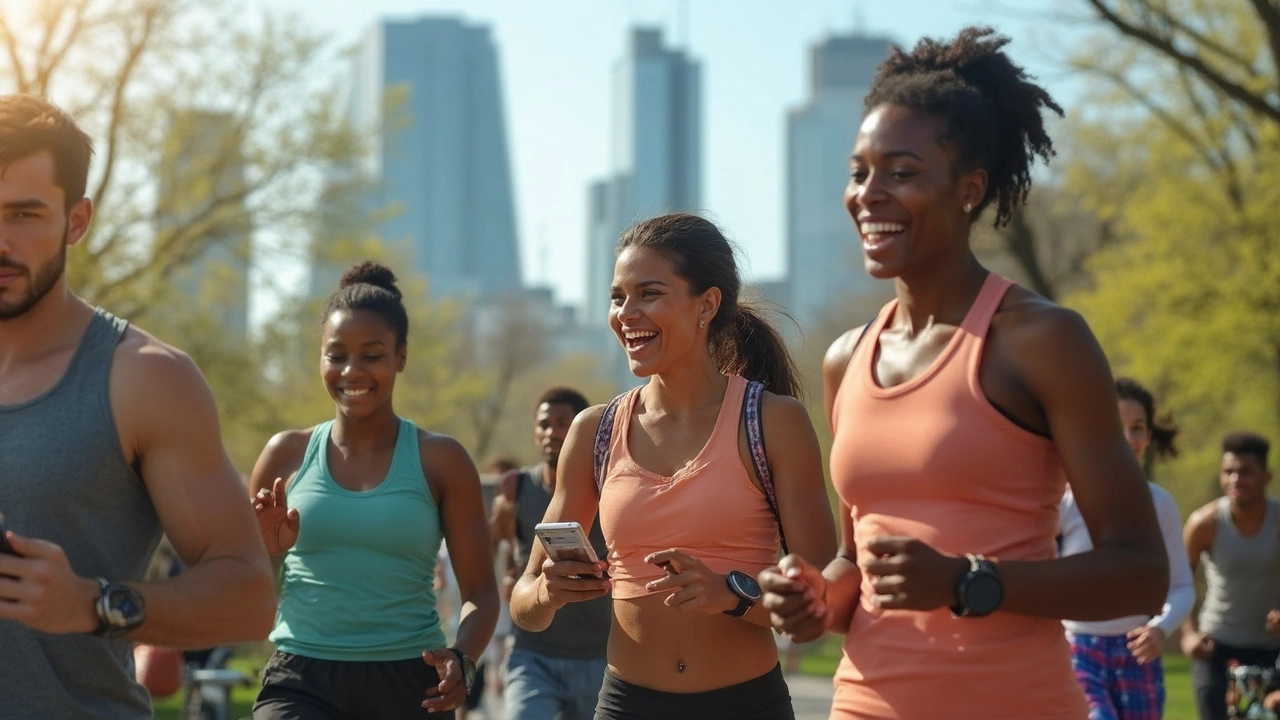
Open your phone, and you’ll probably see a fitness app somewhere near the top of your home screen. But which one are most people opening first thing every morning? It’s not just about downloads — daily active users tell you which app actually gets used to crush workouts, track steps, or just make it out the door for a walk.
Numbers don’t lie: people want results, not just reminders. In 2025, the big winner for daily actives is still Strava. It’s almost a social network at this point, with millions logging runs, bike rides, and even dog walks. Strava saw over 50 million daily active users last month—more than any other fitness app. Why? It’s not just about tracking laps or calories. There’s a huge draw in sharing progress, joining challenges, and honestly, just peeking at your friend’s route. That’s what keeps people opening it every single day.
When you pick a fitness app, look beyond flashy features. The best ones make it almost impossible to skip a day. Find an app that feels a bit like a coach and a bit like a cheerleader. If you’re bored of your current app, try switching it up for an option that rewards consistency with badges or streaks. Sometimes, that’s what sparks the habit that actually sticks longer than New Year’s resolutions.
- Why Daily Active Users Matter in Fitness Apps
- The Fitness App That's Breaking Records in 2025
- Features That Keep Users Coming Back
- How to Choose the Best App for Your Routine
Why Daily Active Users Matter in Fitness Apps
If you’re hunting for the fitness apps people actually use, daily active users (DAUs) are the number to watch. Forget about download counts. Plenty of apps get installed and then collect dust. But daily active users show how many real people open the app every single day and stick with it—whether they’re logging sweaty HIIT sessions or chill step walks.
Apps with lots of DAUs usually mean they deliver on what users need: motivation, simple tracking, maybe even a bit of fun. If an app makes it easy to pop in, record your sets, check your streak, and maybe trash-talk your friends (in a good way, of course), it keeps you coming back. That’s the sign of an app that might actually help with your exercise and health tracking goals.
Want some numbers? Strava, for example, pulls in over 50 million daily active users as of early 2025. That’s more than the total populations of Canada and Australia combined. Peloton, MyFitnessPal, and Nike Training Club all trail behind, but they’re still pulling millions each. Here’s a quick look at recent stats:
| App Name | Daily Active Users (2025) |
|---|---|
| Strava | 50,000,000+ |
| MyFitnessPal | 8,000,000 |
| Nike Training Club | 5,000,000 |
| Peloton | 4,200,000 |
Why care? Apps with strong daily user numbers almost always roll out better updates, more community features, and actual support. If lots of folks use an app every single day, it’s probably worth checking out for yourself. And if you’re aiming to build better habits, picking an app with a vibrant daily community can make it easier to stay consistent—and maybe even make fitness less of a chore.
The Fitness App That's Breaking Records in 2025
When it comes to fitness apps that actually get people moving every day, Strava is stealing the show in 2025. If you think of it as just a running tracker, you’re missing half the story. Strava has grown into the world’s busiest fitness platform, with a massive jump in daily users this year. As of March 2025, Strava is seeing over 50 million daily active users—way ahead of its closest rivals like MyFitnessPal and Fitbit. That’s not a made-up number either—the company posted it on their investor call last month and even tech blogs like TechCrunch picked it up.
Why is everyone glued to Strava? It’s not only about recording workouts. The social vibe is a huge deal. Users can comment, give digital “kudos,” join clubs, and compete on public segments. That sense of community is what turned solo runs and bike rides into something worth sharing, comparing, and talking about. Add in easy syncing from Garmin, Apple Watch, and dozens of other trackers, and you don’t even have to think about data—just get moving and Strava handles the rest.
You want numbers? Here’s how Strava stacks up against runners-up when it comes to average daily users this spring:
| App Name | Daily Active Users (Approx.) |
|---|---|
| Strava | 50,000,000+ |
| MyFitnessPal | 16,000,000 |
| Fitbit | 11,000,000 |
| Adidas Running | 7,000,000 |
Compare those numbers and it’s clear: a dedicated user base often matters more than flashy advertising or celebrity endorsements. If you’re not already on Strava and you like a bit of friendly competition, you might feel left out. But here’s a tip—don’t just follow pro athletes. Look for local clubs or weekly challenges so you get that daily nudge to move, even if it’s just a quick walk around your block. Staying consistent is easier when you know someone else is checking in too.

Features That Keep Users Coming Back
Let’s be real: if a fitness app feels boring or complicated, you’re probably not going to use it more than a week. So, what actually makes people stick with an app like Strava, Fitbit, or MyFitnessPal? It’s all about clever, practical features that hit right where motivation tends to fade.
The apps leading in daily active users have a few things in common:
- Community and Social Connections: Strava has nailed this. Following friends, joining local clubs, and sharing workout results make it more like Instagram for fitness. This social nudge works. Strava even posts that over 40% of its users join group challenges—and people in those groups log workouts 35% more often.
- Streaks and Achievement Badges: People love to see progress. Fitbit and Apple Fitness hand out badges and celebrate streaks. Missing a day feels like breaking a chain, which keeps you coming back (even when Netflix is calling).
- Easy Tracking and Syncing: Apps like MyFitnessPal and Nike Run Club make logging meals, workouts, and steps way too easy. They also sync with smartwatches, scales, and even sleep trackers so you don’t have to double up. The easier it is, the more you’ll use it.
- Personalized Stats and Goals: Top exercise apps use your data to set challenges or recommend workouts just for you. Peloton shows personalized metrics and compares them to your previous best, so you know when you’re actually getting stronger.
If you’re curious how these features stack up, check this out:
| App | Community Features | Streaks / Badges | Device Sync | Personalized Goals |
|---|---|---|---|---|
| Strava | Yes | Yes | Yes | Yes |
| Fitbit | Yes | Yes | Yes | Yes |
| MyFitnessPal | Limited | Yes | Yes | Yes |
| Nike Run Club | Yes | Yes | Yes | Yes |
Thinking about trying these apps? Look for the ones that tick most of these boxes. The right mix of social buzz, habit-forming rewards, fuss-free tracking, and personal stats makes a fitness app feel less like a chore and more like something you want to check—kind of like your favorite social app, but for your health.
How to Choose the Best App for Your Routine
Picking the right fitness app for your actual life is about more than the app’s icon or a flashy ad. What’s your goal? Maybe you want to run faster, track your steps, lose some weight, or just get reminders to move. The good news: there’s a perfect app for every type—even if you’re not a gym nut.
Let’s break it down. If daily motivation is your main struggle, apps like Strava and Nike Training Club give you reminders, badges, and easy ways to compete with friends. For stat junkies who love loads of data, MyFitnessPal is one of the best for calorie tracking and nutrition breakdowns. Into group fitness or yoga? Try apps like Peloton or Down Dog, which offer tons of quick classes on your schedule.
"The best fitness tech is the kind that fits into your daily grind and actually makes you want to use it," says Tim Green, lead analyst at Digital Wellness Review. "It doesn't have to be complicated, but it does need to keep you interested."
Before you commit, check out these quick pointers so you don’t waste time—and money—on the wrong exercise app:
- Get the Free Version First: Most top health tracking apps offer a decent free version. Play around before you pay for premium.
- Check Device Compatibility: Make sure your phone, smartwatch, or tracker actually works with the app. A surprising number of folks get snagged here.
- Test the Community Features: Some thrive on supportive groups or competition, others hate the social media vibe. Peep the community before you join.
- See How It Tracks Progress: An app should log what matters to you, whether that’s steps, calories, streaks, or strength PRs (personal records).
Here’s a quick peek at some top apps and what they’re best at:
| App | Great For | DAUs (April 2025) |
|---|---|---|
| Strava | Running, cycling, social motivation | 50M+ |
| MyFitnessPal | Tracking food, nutrition | 18M+ |
| Peloton | Home workouts, classes | 8M+ |
| Down Dog | Yoga, beginner-friendly | 3.2M+ |
Don’t get stuck on what everyone else is using. Try a couple for a week, track which one you’re actually excited to open, and go with that. Consistency beats perfection every time in the world of most popular fitness apps.
